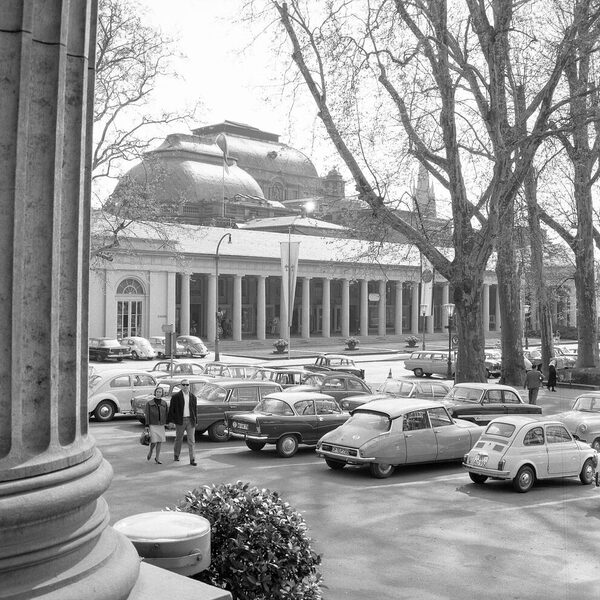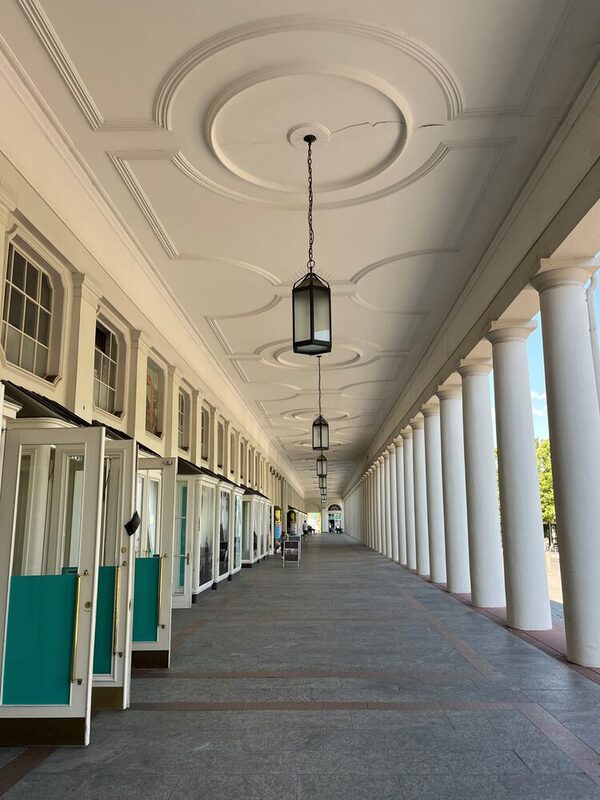Theater Colonnade
The theater colonnade was built in 1838/39 - around ten years after the fountain colonnade. Together they completed the connection between the old Kurhaus and the buildings on Kaiser-Friedrich-Platz created by Christian Zais. The theater colonnade was redesigned several times. After its destruction in the Second World War, it was given its current appearance.
Colonnades as boundaries for squares were particularly widespread in ancient Greece. In Western art, they were particularly popular in the Baroque period, as can be seen most impressively in St. Peter's Square in Rome, created between 1655 and 1667 by Gian Lorenzo Bernini. As early as 1807, in his first design for the Kur- und Gesellschaftshaus, the old Kurhaus (Kurhaus, old), Christian Zais combined three structures with arched colonnades. He had also connected the Nassauer Hof with the old theater by colonnades, as well as his residential building with the Hotel Vier Jahreszeiten. It can therefore be assumed that he already had the idea of enclosing the large square between the Gesellschaftshaus and Wilhelmstrasse with colonnades, but he did not live to see this project realized.
The project, which was very ambitious in terms of urban planning, was first implemented with the construction of the northern colonnade, later known as the fountain colonnade, by Heinrich Jacob Zengerle in 1826/27, followed by the construction of the southern colonnade by Baurat Karl Friedrich Faber (1792 - 1856) in 1838/39. Stylistically, the two colonnades of the same design are typical of classicism, with large dimensions and emphasized simplicity of form. Between a pavilion to the east and west, 46 Doric columns without fluting stand in an even, tight row, supporting the simple entablature and the flat pitched gable roof. In form and function, the colonnades resemble the columned halls known as stoa, which surrounded the agora of Greek and Roman cities.
In Wiesbaden, the colonnades linking the old Kurhaus with the buildings on Kaiser-Friedrich-Platz created by Zais - across Wilhelmstraße - were one of the greatest spatial creations of classicism, futuristic for a city of 8800 inhabitants at the time of its creation and still today a central square for events of all kinds in a large city.
The southern colonnade, later called the theater colonnade, contained high-end stores from the very beginning. When the new theater, today's Hessisches Staatstheater Wiesbaden, was built between 1892 and 1894 by the architectural firm Fellner & Helmer, it was given a neo-baroque risalit in the middle, in which the theater's main entrance was located.
After several conversions as early as the 19th century, the theater colonnade was finally extensively altered in the late 1930s under Eberhard Finsterwalder, the head of the building department and head of the building construction office. The number of stores was considerably reduced and the shopping gallery was completely redesigned. The twelve newly created supraports were painted with the signs of the zodiac based on designs by the painter Ernst Wolff-Malm in collaboration with Karl Otto Hy and Friedrich Schlüßel, whose artist name was Alo Altripp. This can be seen from an inscription in the constellation of Virgo, which has been preserved in a photograph.
After completion of the work, the colonnade was handed over to the public on April 14, 1938 in the presence of Lord Mayor Dr. Erich Mix. (Wiesbadener Tagblatt, WT, 14.4.1938) In the same year, the neo-baroque portico was also demolished and replaced by a simple vestibule in the neo-classical style of the colonnade, which was completed in February 1939.
(WT 4.2.1939)
After the complete destruction of the theater colonnade in the bombing raid of February 2, 1945, reconstruction work began in the 1940s. This was largely based on its immediate pre-war appearance. The artist Erich Leitgeb (1886 - 1950), who created "works of Arcadian serenity" for the eleven wall panels, emerged from the ideas competition for the painterly design of the supraports, whose jury was chaired by city planning officer Finsterwalder.
(WT 19.10.1949)
After Leitgeb's death in February 1950, his wife, the artist Gerda Stryi-Leitgeb (1905 - 1992), whose paintings had been defamed as "degenerate" by the National Socialists, took over the revision of the designs and their execution.
(WT 31.8.1950)
The theater colonnade has essentially been preserved in this form to this day, apart from the fact that it was given a new natural stone floor during the renovation in 1978.
Literature
- Kiesow, Gottfried
The misjudged century. The example of historicism in Wiesbaden, Bonn 2005 (p. 128 ff.).
- Kiesow, Gottfried
Architectural Guide Wiesbaden. The City of Historicism, Bonn 2006 (p. 12 f.).
- Wiesbadener Tagblatt
Issue from April 14, 1938
- Wiesbadener Tagblatt
Issue of February 4, 1939
- Wiesbadener Tagblatt
Issue from October 19, 1949
- Wiesbadener Tagblatt
Issue from August 31, 1950

